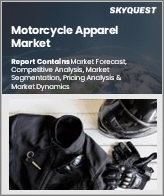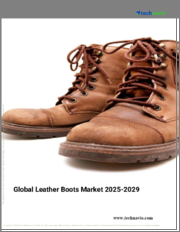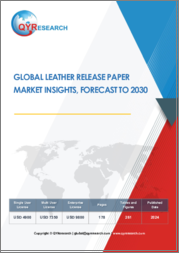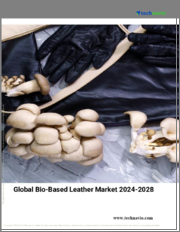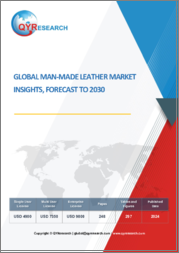
|
시장보고서
상품코드
1866676
세계의 인조피혁 시장 : 시장 점유율과 순위, 전체 판매 및 수요 예측(2025-2031년)Man-made Leather - Global Market Share and Ranking, Overall Sales and Demand Forecast 2025-2031 |
||||||
세계의 인조피혁 시장 규모는 2024년에 205억 달러로 추정되며, 2025년부터 2031년까지 예측 기간 동안 CAGR 7.3%로 성장하여 2031년까지 352억 1,700만 달러로 확대될 것으로 예측됩니다.
본 보고서는 인조피혁의 국경 간 산업 발자국, 자본 배분 패턴, 지역경제의 상호의존성, 공급망 재구축에 대한 최근 관세 조정 및 국제적인 전략적 대응 조치에 대한 종합적인 평가를 제공합니다.
2024년 세계 인조피혁 생산량은 약 47억6500만 평방미터에 달했고, 세계 평균 시장 가격은 평방미터당 약 4.3달러에 달했습니다.
인조피혁은 천연 가죽의 외관과 질감을 모방하도록 설계된 합성 소재를 말합니다. 주로 폴리염화비닐(PVC), 폴리우레탄(PU) 등의 합성 수지를 원료로 하여 특수한 제조 공정을 거쳐 생산됩니다. 내마모성, 내수성, 손쉬운 관리, 저렴한 비용 등의 장점을 가지고 있어 패션, 자동차, 가구, 신발, 가방 등의 산업에서 널리 사용되고 있습니다. 천연 가죽을 대체할 수 있는 친환경적인 대안으로 작용하고 있습니다.
최근 환경보호와 동물보호에 대한 관심이 높아지면서 인조피혁 세계 시장은 꾸준히 성장하고 있습니다. 천연가죽에 비해 인조가죽은 가격이 저렴할 뿐만 아니라 질감, 색감, 기능성에 있어서도 커스터마이징이 가능하여 다양한 산업분야에서 가치 있는 소재가 되고 있습니다. 특히 소비재 산업을 중심으로 많은 분야에서 기존 가죽을 대체하고 있습니다. 패션 업계에서는 환경 부하를 줄이기 위해 인조피혁을 채택하는 브랜드가 증가하고 있습니다. 또한 기술의 발전으로 인조피혁의 성능이 크게 향상되어 외관과 질감에서 진짜 가죽과의 차이가 좁혀지고 있으며, 고급 시장에서의 수용도 확대되고 있습니다.
제조 기술과 기술의 지속적인 혁신으로 세계 인조피혁 시장은 빠르게 성장하고 있습니다. 중국, 인도 등 아시아 국가들이 주요 생산 거점인 반면, 유럽과 북미는 주요 소비 시장입니다. 시장 조사에 따르면, 가구 및 자동차 분야의 수요 증가에 따라 세계 인조피혁 시장은 앞으로도 계속 확대될 것으로 보입니다. 또한, 소비자들의 환경에 대한 인식이 높아지면서 무용매 PU, 생분해성 소재 등 친환경 인조피혁 소재가 시장의 새로운 트렌드로 떠오르고 있습니다.
시장 개척의 기회:
인조피혁 시장에는 수많은 발전 기회가 존재합니다. 첫째, 친환경적이고 지속가능한 소재에 대한 수요 확대는 천연 가죽을 대체할 수 있는 인조피혁에 큰 기회를 가져다주고 있습니다. 소비자의 친환경 제품에 대한 선호도가 높아지는 가운데, 특히 동물의 권리와 환경 보호에 초점을 맞추는 브랜드가 증가하고 있는 패션 업계에서 인조피혁은 큰 시장 기회를 발견하고 있습니다. 다음으로, 제조기술의 발전에 따라 인조피혁의 성능이 크게 향상되어 자동차, 가구, 생활용품 등 다양한 분야에 적용이 가능해졌습니다. 또한, 혁신적인 기술의 도입으로 무용매 PU, 생분해성 소재 등 인조피혁의 다양성이 증가하여 기능성과 지속가능성을 추구하는 다양한 시장과 소비자의 요구에 부응하고 있습니다.
시장 리스크:
광범위한 시장 전망이 있는 반면, 인조피혁 산업은 몇 가지 도전에 직면해 있습니다. 주요 리스크 중 하나는 원자재 가격 변동, 특히 유가 변동에 따른 원자재 가격 변동입니다. 합성 수지의 가격 상승은 인조피혁의 생산 비용 증가로 이어집니다. 또 다른 과제는 특히 고급 제품에서 인조피혁의 품질과 내구성에 대한 회의적인 시각이 여전히 존재한다는 점입니다. 기술 발전이 있었지만, 천연 가죽에 비해 특정 유형의 인조피혁은 여전히 촉감이나 편안함 측면에서 열등할 수 있습니다. 또한, 시장이 빠르게 성장함에 따라 업계 내 경쟁은 더욱 치열해지고 있습니다. 기업은 경쟁 우위를 유지하기 위해 지속적인 기술 혁신과 생산 공정 최적화가 요구됩니다.
다운스트림 수요 동향:
다운스트림 수요 동향은 주로 다음과 같은 분야에 집중되어 있습니다. 첫째, 자동차 산업, 특히 고급 자동차 시트 및 내장재 분야에서 인조피혁의 수요가 꾸준히 증가하고 있습니다. 둘째, 가구 산업, 특히 사무용 가구 및 가정 장식 분야에서 인조피혁의 채택이 증가하고 있습니다. 셋째, 패션 산업, 특히 신발, 핸드백, 의류 분야의 수요는 환경 친화적인 인조피혁 제품을 선호하는 소비자가 증가함에 따라 지속적으로 증가하는 추세를 보이고 있습니다. 마지막으로, 무용매 PU, 생분해성 소재 등 친환경 인조피혁 소재가 점점 더 인기를 얻고 있으며, 지속가능성, 환경 책임, 고품질을 추구하는 소비자의 요구에 부응하고 있습니다.
이 보고서는 인조피혁 세계 시장에 대한 종합적인 분석을 제공하는 것을 목표로 합니다. 총 판매량, 매출, 가격, 주요 기업의 시장 점유율과 순위에 초점을 맞추고, 지역별, 국가별, 유형별, 용도별 분석을 포함하고 있습니다.
이 보고서는 2024년을 기준 연도, 2020년에서 2031년까지의 과거 데이터와 예측 데이터를 포함하여 판매량(천 평방미터)과 매출액(백만 달러)으로 인조피혁 시장의 규모, 추정치 및 예측치를 제시합니다. 정량적, 정성적 분석을 통해 독자들이 인조피혁 관련 사업 전략 및 성장 전략 수립, 시장 경쟁 평가, 현재 시장에서의 자사 포지셔닝 분석, 정보에 입각한 사업적 판단을 할 수 있도록 지원합니다.
시장 세분화
기업별
- Kuraray
- Toray
- Teijin
- Covestro(Bayer)
- Shian Microfiber
- Zhejiang Haobo(Wangkang Group)
- Asahi Kasei
- Duksung
- Daewon Chemical
- Filwel
- Kolon
- San Fang Chemical
- Nanya
- Wenzhou Imitation Leather
- Anhui Anli
- Fujian Tianshou
- Vulcaflex
- Yantai Wanhua
- Shandong Tongda
- Hexin Holdings
- Xiefu New Materials
- Huafon Microfibre
- Double Elephant
- Fujian Topsun
- Benecke-Kaliko
- Kyowa
- Archilles
- CGT
- Ultrafabrics Holdings
유형별 부문
- PVC 가죽
- 일반 PU 가죽
- 마이크로파이버 PU 가죽
- 생태학적 기능 PU 가죽
용도별 부문
- 의류 및 액세서리
- 가구
- 자동차
- 스포츠 용품
- 기타
지역별
- 북미
- 미국
- 캐나다
- 아시아태평양
- 중국
- 일본
- 한국
- 동남아시아
- 인도
- 호주
- 기타 아시아태평양
- 유럽
- 독일
- 프랑스
- 영국
- 이탈리아
- 네덜란드
- 북유럽 국가
- 기타 유럽
- 라틴아메리카
- 멕시코
- 브라질
- 기타 라틴아메리카
- 중동 및 아프리카
- 튀르키예
- 사우디아라비아
- 아랍에미리트
- 기타 중동 및 아프리카
The global market for Man-made Leather was estimated to be worth US$ 20500 million in 2024 and is forecast to a readjusted size of US$ 35217 million by 2031 with a CAGR of 7.3% during the forecast period 2025-2031.
This report provides a comprehensive assessment of recent tariff adjustments and international strategic countermeasures on Man-made Leather cross-border industrial footprints, capital allocation patterns, regional economic interdependencies, and supply chain reconfigurations.
In 2024, global Man-made Leather production reached approximately 4,765 Million sqm, with an average global market price of around US$ 4.3 per sqm.
Man-made leather refers to synthetic materials designed to imitate the look and feel of natural leather. Typically made from synthetic resins such as polyvinyl chloride (PVC) or polyurethane (PU), it is produced through specialized manufacturing processes that offer advantages such as wear resistance, water resistance, easy maintenance, and lower cost. It is widely used in industries such as fashion, automotive, furniture, footwear, and bags, serving as an eco-friendly alternative to natural leather.
The global market for man-made leather has experienced steady growth in recent years, driven by increasing environmental awareness and a focus on animal rights. Compared to natural leather, man-made leather is not only more affordable but also customizable in terms of texture, color, and functionality, making it a valuable material across various industries. It is gradually replacing traditional leather in many sectors, particularly in the consumer goods industry. In the fashion industry, many brands are now opting for man-made leather to reduce their environmental impact. Moreover, with advancements in technology, the performance of man-made leather has significantly improved, closing the gap in appearance and texture with real leather, which increases its acceptance in high-end markets.
With continuous innovations in manufacturing techniques and technology, the global man-made leather market is growing rapidly. Countries in Asia, such as China and India, serve as major production hubs, while Europe and North America are key consumer markets. According to market research, the global man-made leather market is expected to continue expanding, with increasing demand in the furniture and automotive sectors. Furthermore, as consumers become more environmentally conscious, eco-friendly man-made leather materials, such as solvent-free PU and biodegradable options, are emerging as hot trends in the market.
Market Development Opportunities:
The man-made leather market presents numerous development opportunities. First, the growing demand for eco-friendly and sustainable materials creates a significant opportunity for man-made leather as an alternative to natural leather. With increasing consumer preference for environmentally friendly products, man-made leather has found a substantial market opportunity, especially in the fashion industry, where brands are increasingly focused on animal rights and environmental protection. Secondly, as production techniques continue to advance, the performance of man-made leather has improved significantly, making it suitable for a wider range of applications in automotive, furniture, and household sectors. Additionally, the introduction of innovative technologies has increased the diversity of man-made leather materials, such as solvent-free PU and biodegradable options, meeting the needs of various markets and consumers for functionality and sustainability.
Market Risks:
Despite the broad market prospects, the man-made leather industry faces some challenges. One of the primary risks is the fluctuation of raw material prices, especially in the context of oil price changes. The price of synthetic resins can rise, increasing the production costs of man-made leather. Another challenge is the lingering skepticism regarding the quality and durability of man-made leather, particularly in high-end products. Although technological advancements have been made, certain types of man-made leather still fall short in terms of feel and comfort when compared to natural leather. Moreover, as the market grows rapidly, competition within the industry intensifies. Companies must continuously innovate and optimize production processes to maintain their competitive edge.
Downstream Demand Trends:
Downstream demand trends are primarily focused on the following areas: First, the automotive industry is seeing steady growth in demand for man-made leather, particularly for premium car seats and interior applications. Second, the furniture industry, especially in office furniture and home decor, is increasingly adopting man-made leather. Third, demand from the fashion industry, especially in footwear, handbags, and clothing, continues to rise, as more consumers prefer eco-friendly man-made leather products. Lastly, eco-friendly man-made leather materials, such as solvent-free PU and biodegradable options, are becoming increasingly popular, meeting consumer demand for sustainability, environmental responsibility, and high quality.
This report aims to provide a comprehensive presentation of the global market for Man-made Leather, focusing on the total sales volume, sales revenue, price, key companies market share and ranking, together with an analysis of Man-made Leather by region & country, by Type, and by Application.
The Man-made Leather market size, estimations, and forecasts are provided in terms of sales volume (K Sqm) and sales revenue ($ millions), considering 2024 as the base year, with history and forecast data for the period from 2020 to 2031. With both quantitative and qualitative analysis, to help readers develop business/growth strategies, assess the market competitive situation, analyze their position in the current marketplace, and make informed business decisions regarding Man-made Leather.
Market Segmentation
By Company
- Kuraray
- Toray
- Teijin
- Covestro (Bayer)
- Shian Microfiber
- Zhejiang Haobo (Wangkang Group)
- Asahi Kasei
- Duksung
- Daewon Chemical
- Filwel
- Kolon
- San Fang Chemical
- Nanya
- Wenzhou Imitation Leather
- Anhui Anli
- Fujian Tianshou
- Vulcaflex
- Yantai Wanhua
- Shandong Tongda
- Hexin Holdings
- Xiefu New Materials
- Huafon Microfibre
- Double Elephant
- Fujian Topsun
- Benecke-Kaliko
- Kyowa
- Archilles
- CGT
- Ultrafabrics Holdings
Segment by Type
- PVC Leather
- Normal PU Leather
- Microfiber PU Leather
- Ecological function PU Leather
Segment by Application
- Apparel & Accessories
- Furnishing
- Automotive
- Sports Goods
- Others
By Region
- North America
- United States
- Canada
- Asia-Pacific
- China
- Japan
- South Korea
- Southeast Asia
- India
- Australia
- Rest of Asia-Pacific
- Europe
- Germany
- France
- U.K.
- Italy
- Netherlands
- Nordic Countries
- Rest of Europe
- Latin America
- Mexico
- Brazil
- Rest of Latin America
- Middle East & Africa
- Turkey
- Saudi Arabia
- UAE
- Rest of MEA
Chapter Outline
Chapter 1: Introduces the report scope of the report, global total market size (value, volume and price). This chapter also provides the market dynamics, latest developments of the market, the driving factors and restrictive factors of the market, the challenges and risks faced by manufacturers in the industry, and the analysis of relevant policies in the industry.
Chapter 2: Detailed analysis of Man-made Leather manufacturers competitive landscape, price, sales and revenue market share, latest development plan, merger, and acquisition information, etc.
Chapter 3: Provides the analysis of various market segments by Type, covering the market size and development potential of each market segment, to help readers find the blue ocean market in different market segments.
Chapter 4: Provides the analysis of various market segments by Application, covering the market size and development potential of each market segment, to help readers find the blue ocean market in different downstream markets.
Chapter 5: Sales, revenue of Man-made Leather in regional level. It provides a quantitative analysis of the market size and development potential of each region and introduces the market development, future development prospects, market space, and market size of each country in the world.
Chapter 6: Sales, revenue of Man-made Leather in country level. It provides sigmate data by Type, and by Application for each country/region.
Chapter 7: Provides profiles of key players, introducing the basic situation of the main companies in the market in detail, including product sales, revenue, price, gross margin, product introduction, recent development, etc.
Chapter 8: Analysis of industrial chain, including the upstream and downstream of the industry.
Chapter 9: Conclusion.
Table of Contents
1 Market Overview
- 1.1 Man-made Leather Product Introduction
- 1.2 Global Man-made Leather Market Size Forecast
- 1.2.1 Global Man-made Leather Sales Value (2020-2031)
- 1.2.2 Global Man-made Leather Sales Volume (2020-2031)
- 1.2.3 Global Man-made Leather Sales Price (2020-2031)
- 1.3 Man-made Leather Market Trends & Drivers
- 1.3.1 Man-made Leather Industry Trends
- 1.3.2 Man-made Leather Market Drivers & Opportunity
- 1.3.3 Man-made Leather Market Challenges
- 1.3.4 Man-made Leather Market Restraints
- 1.4 Assumptions and Limitations
- 1.5 Study Objectives
- 1.6 Years Considered
2 Competitive Analysis by Company
- 2.1 Global Man-made Leather Players Revenue Ranking (2024)
- 2.2 Global Man-made Leather Revenue by Company (2020-2025)
- 2.3 Global Man-made Leather Players Sales Volume Ranking (2024)
- 2.4 Global Man-made Leather Sales Volume by Company Players (2020-2025)
- 2.5 Global Man-made Leather Average Price by Company (2020-2025)
- 2.6 Key Manufacturers Man-made Leather Manufacturing Base and Headquarters
- 2.7 Key Manufacturers Man-made Leather Product Offered
- 2.8 Key Manufacturers Time to Begin Mass Production of Man-made Leather
- 2.9 Man-made Leather Market Competitive Analysis
- 2.9.1 Man-made Leather Market Concentration Rate (2020-2025)
- 2.9.2 Global 5 and 10 Largest Manufacturers by Man-made Leather Revenue in 2024
- 2.9.3 Global Top Manufacturers by Company Type (Tier 1, Tier 2, and Tier 3) & (based on the Revenue in Man-made Leather as of 2024)
- 2.10 Mergers & Acquisitions, Expansion
3 Segmentation by Type
- 3.1 Introduction by Type
- 3.1.1 PVC Leather
- 3.1.2 Normal PU Leather
- 3.1.3 Microfiber PU Leather
- 3.1.4 Ecological function PU Leather
- 3.2 Global Man-made Leather Sales Value by Type
- 3.2.1 Global Man-made Leather Sales Value by Type (2020 VS 2024 VS 2031)
- 3.2.2 Global Man-made Leather Sales Value, by Type (2020-2031)
- 3.2.3 Global Man-made Leather Sales Value, by Type (%) (2020-2031)
- 3.3 Global Man-made Leather Sales Volume by Type
- 3.3.1 Global Man-made Leather Sales Volume by Type (2020 VS 2024 VS 2031)
- 3.3.2 Global Man-made Leather Sales Volume, by Type (2020-2031)
- 3.3.3 Global Man-made Leather Sales Volume, by Type (%) (2020-2031)
- 3.4 Global Man-made Leather Average Price by Type (2020-2031)
4 Segmentation by Application
- 4.1 Introduction by Application
- 4.1.1 Apparel & Accessories
- 4.1.2 Furnishing
- 4.1.3 Automotive
- 4.1.4 Sports Goods
- 4.1.5 Others
- 4.2 Global Man-made Leather Sales Value by Application
- 4.2.1 Global Man-made Leather Sales Value by Application (2020 VS 2024 VS 2031)
- 4.2.2 Global Man-made Leather Sales Value, by Application (2020-2031)
- 4.2.3 Global Man-made Leather Sales Value, by Application (%) (2020-2031)
- 4.3 Global Man-made Leather Sales Volume by Application
- 4.3.1 Global Man-made Leather Sales Volume by Application (2020 VS 2024 VS 2031)
- 4.3.2 Global Man-made Leather Sales Volume, by Application (2020-2031)
- 4.3.3 Global Man-made Leather Sales Volume, by Application (%) (2020-2031)
- 4.4 Global Man-made Leather Average Price by Application (2020-2031)
5 Segmentation by Region
- 5.1 Global Man-made Leather Sales Value by Region
- 5.1.1 Global Man-made Leather Sales Value by Region: 2020 VS 2024 VS 2031
- 5.1.2 Global Man-made Leather Sales Value by Region (2020-2025)
- 5.1.3 Global Man-made Leather Sales Value by Region (2026-2031)
- 5.1.4 Global Man-made Leather Sales Value by Region (%), (2020-2031)
- 5.2 Global Man-made Leather Sales Volume by Region
- 5.2.1 Global Man-made Leather Sales Volume by Region: 2020 VS 2024 VS 2031
- 5.2.2 Global Man-made Leather Sales Volume by Region (2020-2025)
- 5.2.3 Global Man-made Leather Sales Volume by Region (2026-2031)
- 5.2.4 Global Man-made Leather Sales Volume by Region (%), (2020-2031)
- 5.3 Global Man-made Leather Average Price by Region (2020-2031)
- 5.4 North America
- 5.4.1 North America Man-made Leather Sales Value, 2020-2031
- 5.4.2 North America Man-made Leather Sales Value by Country (%), 2024 VS 2031
- 5.5 Europe
- 5.5.1 Europe Man-made Leather Sales Value, 2020-2031
- 5.5.2 Europe Man-made Leather Sales Value by Country (%), 2024 VS 2031
- 5.6 Asia Pacific
- 5.6.1 Asia Pacific Man-made Leather Sales Value, 2020-2031
- 5.6.2 Asia Pacific Man-made Leather Sales Value by Region (%), 2024 VS 2031
- 5.7 South America
- 5.7.1 South America Man-made Leather Sales Value, 2020-2031
- 5.7.2 South America Man-made Leather Sales Value by Country (%), 2024 VS 2031
- 5.8 Middle East & Africa
- 5.8.1 Middle East & Africa Man-made Leather Sales Value, 2020-2031
- 5.8.2 Middle East & Africa Man-made Leather Sales Value by Country (%), 2024 VS 2031
6 Segmentation by Key Countries/Regions
- 6.1 Key Countries/Regions Man-made Leather Sales Value Growth Trends, 2020 VS 2024 VS 2031
- 6.2 Key Countries/Regions Man-made Leather Sales Value and Sales Volume
- 6.2.1 Key Countries/Regions Man-made Leather Sales Value, 2020-2031
- 6.2.2 Key Countries/Regions Man-made Leather Sales Volume, 2020-2031
- 6.3 United States
- 6.3.1 United States Man-made Leather Sales Value, 2020-2031
- 6.3.2 United States Man-made Leather Sales Value by Type (%), 2024 VS 2031
- 6.3.3 United States Man-made Leather Sales Value by Application, 2024 VS 2031
- 6.4 Europe
- 6.4.1 Europe Man-made Leather Sales Value, 2020-2031
- 6.4.2 Europe Man-made Leather Sales Value by Type (%), 2024 VS 2031
- 6.4.3 Europe Man-made Leather Sales Value by Application, 2024 VS 2031
- 6.5 China
- 6.5.1 China Man-made Leather Sales Value, 2020-2031
- 6.5.2 China Man-made Leather Sales Value by Type (%), 2024 VS 2031
- 6.5.3 China Man-made Leather Sales Value by Application, 2024 VS 2031
- 6.6 Japan
- 6.6.1 Japan Man-made Leather Sales Value, 2020-2031
- 6.6.2 Japan Man-made Leather Sales Value by Type (%), 2024 VS 2031
- 6.6.3 Japan Man-made Leather Sales Value by Application, 2024 VS 2031
- 6.7 South Korea
- 6.7.1 South Korea Man-made Leather Sales Value, 2020-2031
- 6.7.2 South Korea Man-made Leather Sales Value by Type (%), 2024 VS 2031
- 6.7.3 South Korea Man-made Leather Sales Value by Application, 2024 VS 2031
- 6.8 Southeast Asia
- 6.8.1 Southeast Asia Man-made Leather Sales Value, 2020-2031
- 6.8.2 Southeast Asia Man-made Leather Sales Value by Type (%), 2024 VS 2031
- 6.8.3 Southeast Asia Man-made Leather Sales Value by Application, 2024 VS 2031
- 6.9 India
- 6.9.1 India Man-made Leather Sales Value, 2020-2031
- 6.9.2 India Man-made Leather Sales Value by Type (%), 2024 VS 2031
- 6.9.3 India Man-made Leather Sales Value by Application, 2024 VS 2031
7 Company Profiles
- 7.1 Kuraray
- 7.1.1 Kuraray Company Information
- 7.1.2 Kuraray Introduction and Business Overview
- 7.1.3 Kuraray Man-made Leather Sales, Revenue, Price and Gross Margin (2020-2025)
- 7.1.4 Kuraray Man-made Leather Product Offerings
- 7.1.5 Kuraray Recent Development
- 7.2 Toray
- 7.2.1 Toray Company Information
- 7.2.2 Toray Introduction and Business Overview
- 7.2.3 Toray Man-made Leather Sales, Revenue, Price and Gross Margin (2020-2025)
- 7.2.4 Toray Man-made Leather Product Offerings
- 7.2.5 Toray Recent Development
- 7.3 Teijin
- 7.3.1 Teijin Company Information
- 7.3.2 Teijin Introduction and Business Overview
- 7.3.3 Teijin Man-made Leather Sales, Revenue, Price and Gross Margin (2020-2025)
- 7.3.4 Teijin Man-made Leather Product Offerings
- 7.3.5 Teijin Recent Development
- 7.4 Covestro (Bayer)
- 7.4.1 Covestro (Bayer) Company Information
- 7.4.2 Covestro (Bayer) Introduction and Business Overview
- 7.4.3 Covestro (Bayer) Man-made Leather Sales, Revenue, Price and Gross Margin (2020-2025)
- 7.4.4 Covestro (Bayer) Man-made Leather Product Offerings
- 7.4.5 Covestro (Bayer) Recent Development
- 7.5 Shian Microfiber
- 7.5.1 Shian Microfiber Company Information
- 7.5.2 Shian Microfiber Introduction and Business Overview
- 7.5.3 Shian Microfiber Man-made Leather Sales, Revenue, Price and Gross Margin (2020-2025)
- 7.5.4 Shian Microfiber Man-made Leather Product Offerings
- 7.5.5 Shian Microfiber Recent Development
- 7.6 Zhejiang Haobo (Wangkang Group)
- 7.6.1 Zhejiang Haobo (Wangkang Group) Company Information
- 7.6.2 Zhejiang Haobo (Wangkang Group) Introduction and Business Overview
- 7.6.3 Zhejiang Haobo (Wangkang Group) Man-made Leather Sales, Revenue, Price and Gross Margin (2020-2025)
- 7.6.4 Zhejiang Haobo (Wangkang Group) Man-made Leather Product Offerings
- 7.6.5 Zhejiang Haobo (Wangkang Group) Recent Development
- 7.7 Asahi Kasei
- 7.7.1 Asahi Kasei Company Information
- 7.7.2 Asahi Kasei Introduction and Business Overview
- 7.7.3 Asahi Kasei Man-made Leather Sales, Revenue, Price and Gross Margin (2020-2025)
- 7.7.4 Asahi Kasei Man-made Leather Product Offerings
- 7.7.5 Asahi Kasei Recent Development
- 7.8 Duksung
- 7.8.1 Duksung Company Information
- 7.8.2 Duksung Introduction and Business Overview
- 7.8.3 Duksung Man-made Leather Sales, Revenue, Price and Gross Margin (2020-2025)
- 7.8.4 Duksung Man-made Leather Product Offerings
- 7.8.5 Duksung Recent Development
- 7.9 Daewon Chemical
- 7.9.1 Daewon Chemical Company Information
- 7.9.2 Daewon Chemical Introduction and Business Overview
- 7.9.3 Daewon Chemical Man-made Leather Sales, Revenue, Price and Gross Margin (2020-2025)
- 7.9.4 Daewon Chemical Man-made Leather Product Offerings
- 7.9.5 Daewon Chemical Recent Development
- 7.10 Filwel
- 7.10.1 Filwel Company Information
- 7.10.2 Filwel Introduction and Business Overview
- 7.10.3 Filwel Man-made Leather Sales, Revenue, Price and Gross Margin (2020-2025)
- 7.10.4 Filwel Man-made Leather Product Offerings
- 7.10.5 Filwel Recent Development
- 7.11 Kolon
- 7.11.1 Kolon Company Information
- 7.11.2 Kolon Introduction and Business Overview
- 7.11.3 Kolon Man-made Leather Sales, Revenue, Price and Gross Margin (2020-2025)
- 7.11.4 Kolon Man-made Leather Product Offerings
- 7.11.5 Kolon Recent Development
- 7.12 San Fang Chemical
- 7.12.1 San Fang Chemical Company Information
- 7.12.2 San Fang Chemical Introduction and Business Overview
- 7.12.3 San Fang Chemical Man-made Leather Sales, Revenue, Price and Gross Margin (2020-2025)
- 7.12.4 San Fang Chemical Man-made Leather Product Offerings
- 7.12.5 San Fang Chemical Recent Development
- 7.13 Nanya
- 7.13.1 Nanya Company Information
- 7.13.2 Nanya Introduction and Business Overview
- 7.13.3 Nanya Man-made Leather Sales, Revenue, Price and Gross Margin (2020-2025)
- 7.13.4 Nanya Man-made Leather Product Offerings
- 7.13.5 Nanya Recent Development
- 7.14 Wenzhou Imitation Leather
- 7.14.1 Wenzhou Imitation Leather Company Information
- 7.14.2 Wenzhou Imitation Leather Introduction and Business Overview
- 7.14.3 Wenzhou Imitation Leather Man-made Leather Sales, Revenue, Price and Gross Margin (2020-2025)
- 7.14.4 Wenzhou Imitation Leather Man-made Leather Product Offerings
- 7.14.5 Wenzhou Imitation Leather Recent Development
- 7.15 Anhui Anli
- 7.15.1 Anhui Anli Company Information
- 7.15.2 Anhui Anli Introduction and Business Overview
- 7.15.3 Anhui Anli Man-made Leather Sales, Revenue, Price and Gross Margin (2020-2025)
- 7.15.4 Anhui Anli Man-made Leather Product Offerings
- 7.15.5 Anhui Anli Recent Development
- 7.16 Fujian Tianshou
- 7.16.1 Fujian Tianshou Company Information
- 7.16.2 Fujian Tianshou Introduction and Business Overview
- 7.16.3 Fujian Tianshou Man-made Leather Sales, Revenue, Price and Gross Margin (2020-2025)
- 7.16.4 Fujian Tianshou Man-made Leather Product Offerings
- 7.16.5 Fujian Tianshou Recent Development
- 7.17 Vulcaflex
- 7.17.1 Vulcaflex Company Information
- 7.17.2 Vulcaflex Introduction and Business Overview
- 7.17.3 Vulcaflex Man-made Leather Sales, Revenue, Price and Gross Margin (2020-2025)
- 7.17.4 Vulcaflex Man-made Leather Product Offerings
- 7.17.5 Vulcaflex Recent Development
- 7.18 Yantai Wanhua
- 7.18.1 Yantai Wanhua Company Information
- 7.18.2 Yantai Wanhua Introduction and Business Overview
- 7.18.3 Yantai Wanhua Man-made Leather Sales, Revenue, Price and Gross Margin (2020-2025)
- 7.18.4 Yantai Wanhua Man-made Leather Product Offerings
- 7.18.5 Yantai Wanhua Recent Development
- 7.19 Shandong Tongda
- 7.19.1 Shandong Tongda Company Information
- 7.19.2 Shandong Tongda Introduction and Business Overview
- 7.19.3 Shandong Tongda Man-made Leather Sales, Revenue, Price and Gross Margin (2020-2025)
- 7.19.4 Shandong Tongda Man-made Leather Product Offerings
- 7.19.5 Shandong Tongda Recent Development
- 7.20 Hexin Holdings
- 7.20.1 Hexin Holdings Company Information
- 7.20.2 Hexin Holdings Introduction and Business Overview
- 7.20.3 Hexin Holdings Man-made Leather Sales, Revenue, Price and Gross Margin (2020-2025)
- 7.20.4 Hexin Holdings Man-made Leather Product Offerings
- 7.20.5 Hexin Holdings Recent Development
- 7.21 Xiefu New Materials
- 7.21.1 Xiefu New Materials Company Information
- 7.21.2 Xiefu New Materials Introduction and Business Overview
- 7.21.3 Xiefu New Materials Man-made Leather Sales, Revenue, Price and Gross Margin (2020-2025)
- 7.21.4 Xiefu New Materials Man-made Leather Product Offerings
- 7.21.5 Xiefu New Materials Recent Development
- 7.22 Huafon Microfibre
- 7.22.1 Huafon Microfibre Company Information
- 7.22.2 Huafon Microfibre Introduction and Business Overview
- 7.22.3 Huafon Microfibre Man-made Leather Sales, Revenue, Price and Gross Margin (2020-2025)
- 7.22.4 Huafon Microfibre Man-made Leather Product Offerings
- 7.22.5 Huafon Microfibre Recent Development
- 7.23 Double Elephant
- 7.23.1 Double Elephant Company Information
- 7.23.2 Double Elephant Introduction and Business Overview
- 7.23.3 Double Elephant Man-made Leather Sales, Revenue, Price and Gross Margin (2020-2025)
- 7.23.4 Double Elephant Man-made Leather Product Offerings
- 7.23.5 Double Elephant Recent Development
- 7.24 Fujian Topsun
- 7.24.1 Fujian Topsun Company Information
- 7.24.2 Fujian Topsun Introduction and Business Overview
- 7.24.3 Fujian Topsun Man-made Leather Sales, Revenue, Price and Gross Margin (2020-2025)
- 7.24.4 Fujian Topsun Man-made Leather Product Offerings
- 7.24.5 Fujian Topsun Recent Development
- 7.25 Benecke-Kaliko
- 7.25.1 Benecke-Kaliko Company Information
- 7.25.2 Benecke-Kaliko Introduction and Business Overview
- 7.25.3 Benecke-Kaliko Man-made Leather Sales, Revenue, Price and Gross Margin (2020-2025)
- 7.25.4 Benecke-Kaliko Man-made Leather Product Offerings
- 7.25.5 Benecke-Kaliko Recent Development
- 7.26 Kyowa
- 7.26.1 Kyowa Company Information
- 7.26.2 Kyowa Introduction and Business Overview
- 7.26.3 Kyowa Man-made Leather Sales, Revenue, Price and Gross Margin (2020-2025)
- 7.26.4 Kyowa Man-made Leather Product Offerings
- 7.26.5 Kyowa Recent Development
- 7.27 Archilles
- 7.27.1 Archilles Company Information
- 7.27.2 Archilles Introduction and Business Overview
- 7.27.3 Archilles Man-made Leather Sales, Revenue, Price and Gross Margin (2020-2025)
- 7.27.4 Archilles Man-made Leather Product Offerings
- 7.27.5 Archilles Recent Development
- 7.28 CGT
- 7.28.1 CGT Company Information
- 7.28.2 CGT Introduction and Business Overview
- 7.28.3 CGT Man-made Leather Sales, Revenue, Price and Gross Margin (2020-2025)
- 7.28.4 CGT Man-made Leather Product Offerings
- 7.28.5 CGT Recent Development
- 7.29 Ultrafabrics Holdings
- 7.29.1 Ultrafabrics Holdings Company Information
- 7.29.2 Ultrafabrics Holdings Introduction and Business Overview
- 7.29.3 Ultrafabrics Holdings Man-made Leather Sales, Revenue, Price and Gross Margin (2020-2025)
- 7.29.4 Ultrafabrics Holdings Man-made Leather Product Offerings
- 7.29.5 Ultrafabrics Holdings Recent Development
8 Industry Chain Analysis
- 8.1 Man-made Leather Industrial Chain
- 8.2 Man-made Leather Upstream Analysis
- 8.2.1 Key Raw Materials
- 8.2.2 Raw Materials Key Suppliers
- 8.2.3 Manufacturing Cost Structure
- 8.3 Midstream Analysis
- 8.4 Downstream Analysis (Customers Analysis)
- 8.5 Sales Model and Sales Channels
- 8.5.1 Man-made Leather Sales Model
- 8.5.2 Sales Channel
- 8.5.3 Man-made Leather Distributors
9 Research Findings and Conclusion
10 Appendix
- 10.1 Research Methodology
- 10.1.1 Methodology/Research Approach
- 10.1.1.1 Research Programs/Design
- 10.1.1.2 Market Size Estimation
- 10.1.1.3 Market Breakdown and Data Triangulation
- 10.1.2 Data Source
- 10.1.2.1 Secondary Sources
- 10.1.2.2 Primary Sources
- 10.1.1 Methodology/Research Approach
- 10.2 Author Details
- 10.3 Disclaimer







